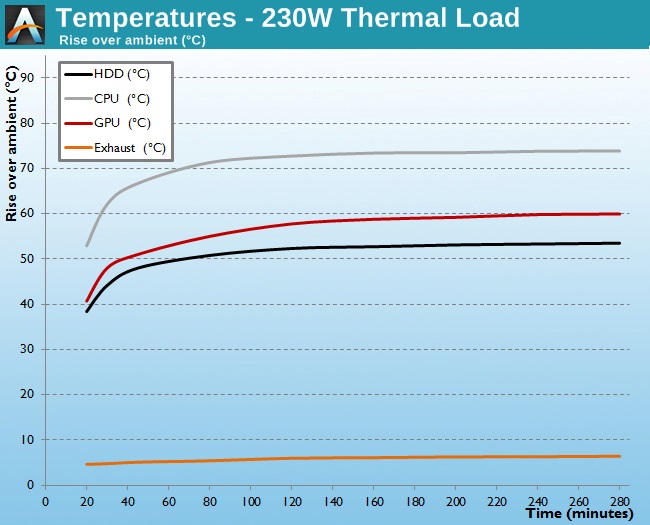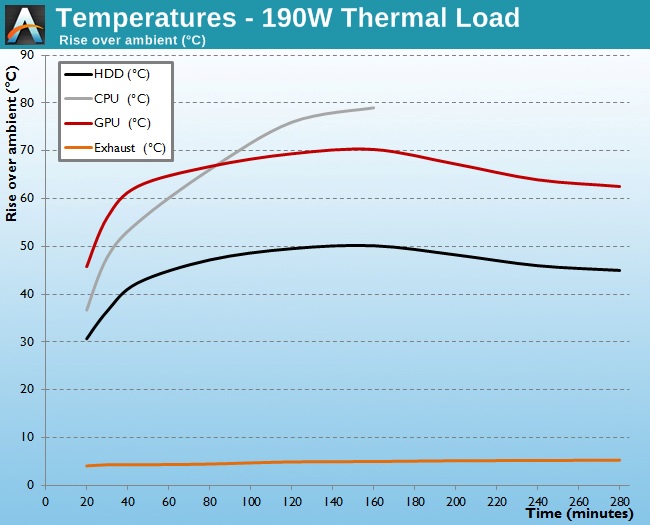SilverStone ML04 & ML05 Slim HTPC Cases Review
by E. Fylladitakis on April 18, 2014 2:30 PM EST- Posted in
- Cases/Cooling/PSUs
- HTPC
- SilverStone
- desktops
Test setup
Professional testing requires the emulation of real-world situations for repeatable results; thus, a perfectly controllable test setup and environment is required, especially for comparable results. Testing the thermal performance of any case with a typical real-world setup technically limits the comparability of the results to this setup alone, as an active system interacts with its environment and the change of a single component alters a myriad of variables. As such, we developed synthetic loads that emulate the thermal output of real systems, with the benefit being that the outputs and loads are passive, steady, and quantifiable. Our thermal testing shows the thermal capabilities of the case alone, as it must cope with the entire thermal load by itself, regardless of the system installed inside it.
Laboratory data loggers are being used to monitor the PT100 sensors and control the safety relays, which are fully accessible via our custom software. Three such loads have been developed. The Micro-ATX version simulates a 180W CPU, 40W VRM, 20W RAM and 1 × 120W GPU card thermal load. The Mini-ITX version simulates a 150W CPU, 30W VRM, 20W RAM and 1 × 120W GPU card thermal load. For low-profile card setups, we are using a 50W dummy GPU card instead. Finally, 2.5" and 3.5" HDD dummy loads have also been created, converting 15W and 30W of electrical power to thermal, respectively. Obviously, the thermal load can be very high and only the best of cases will be able to handle it for more than a few minutes, but we'll be able to quickly differentiate between cases.
Results and discussion
We normally test each setup with the maximum possible load and, for reference, with a lower load as well. For example, the maximum thermal load that our Mini-ITX test setup is capable of over 350W. However, due to the design of both the Milo ML04 and Milo ML05, we cannot really use our full-size GPU load. We should also remind you that neither of these cases has any stock cooling options installed. Even with the low-profile 50W simulated card, both cases could not cope with the stress that our test system was causing for more than a few minutes at maximum power; neither has been designed for handling loads anywhere near such levels. We are thus forced to perform testing only with the minimum possible load, which is:
- 230W for the Milo ML04 (90W CPU, 40W VRM, 20W RAM, 30W HDD and 50W GPU)
- 190W for the Milo ML05 (75W CPU, 30W VRM, 20W RAM, 15W HDD and 50W GPU)
We did not perform any noise-related testing because, well, there was no noise to account for. Neither case has any stock cooling options installed and therefore our instruments would read nothing more than the background noise of the room itself.
The thermal performance of the Silverstone Milo ML04 is mediocre at best, yet very reasonable for a slim desktop chassis with zero stock cooling options. It manages to handle our 230Watt thermal load, though just barely, for several hours, which is more than what we could have hoped for from a case of such small proportions and zero active cooling. We should note that such a thermal load is still about twice as high as the most powerful system most users are likely to install in the Milo ML04 and that a real system will almost certainly have active airflow; we are using such powerful loads because we are stress-testing the designs. The addition of a few exhaust fans would vastly improve these thermal performance figures but we hardly see the point; the Milo ML04 is more than capable to house a very good HTPC and for such systems low noise operation is a far greater priority rather than a few degrees Celsius.
Silverstone Milo ML04B
Unfortunately, the thermal testing of the Milo ML05 was cut a little early, as the tiny case proved unable to handle the 190Watt load for prolonged periods of time. Our safety system decoupled the CPU/VRM load entirely due to overheating; we left the system running for reference but the thermal figures beyond that point have little meaning, as the load has been reduced down to 85W. Still, the tiny case handled a great thermal load for nearly three hours without any activce cooling at all, which is rather impressive. Again, the addition of active cooling would help the thermal performance of the Milo ML05 dramatically but, as with the Milo ML04, we do not believe there is a point in doing so. After all, this is not an enclosure meant to house GTX TITAN or R9 290X GPUs; the thermal load from a typical HTPC Mini-ITX system should not be more than 20-30W, and idle loads will be even lower.
Silverstone Milo ML05B












39 Comments
View All Comments
johnny_boy - Saturday, April 19, 2014 - link
The ML04 looks alright (not great, not terrible) but the ITX ML05 is terribly ugly. Diamond buttons? Big plastic strip across the front? There's a serious lack of nice, affordable, ITX cases especially in this HTPC form factor.Dave12311231 - Saturday, April 19, 2014 - link
I would like to use the Milo ML05 with a 19V DC connector equipped motherboard and a Broadwell or future AMD system. This would negate the cables from an internal PSU whilst still having a very small case, hopefully cheaper than a NUC system overall.jabber - Saturday, April 19, 2014 - link
These are NOT great looking cases.C'mon people try harder!
Alan G - Saturday, April 19, 2014 - link
Well they do look better than the traditional cable box that comes courtesy of your provider!I've built several HTPCs for family and friends over the past six months and these cases should be OK. You don't need any graphics cards with new CPUs (I use Intel but I'm sure the same is true with AMD on board graphics). In addition HTPC systems are not energy demanding and I've got one in a Lian Li PCQ-27 case which is passively cooled. Temperatures under operating conditions with only the Intel stock cooler run just over 30C which is fine. The review is correct about the lack of choices in PSUs for these applications. I've been using Seasonic G-360s which work just fine and are silent.
Thanks for this posting and continue to find some small HTPC case to review.
irusun - Saturday, April 19, 2014 - link
Agree.And especially the "mirror" front on the ML05 sounds awful... why would I want that sitting under/next to my TV bouncing all sorts of reflections?
jtd871 - Monday, April 21, 2014 - link
Silverstone now offers the recent ML06, which is the same chasis as the 05, but dumps the acrylic front panel for anodized aluminum like the 04.irusun - Saturday, April 19, 2014 - link
I'm aware others have had similar comments, and I'm sincerely not trying to hurt E. Fylladitakis feelings or question his technical competence, and I'm rooting for him to succeed, but he really needs help with the writing. It's pretty obvious that english is not his first language, and it results in wordy paragraphs, weird phrasings (at times it sounds like it was written by a bot), and it's just plain difficult to follow at times. I expect better writing at Anandtech.irusun - Saturday, April 19, 2014 - link
I'm surprised there's so little mention of "noise" in HTPC case reviews where noise is one of the primary issues of concern. I understand what was stated in the article about not being able to quantify results above background room noise, but how about some subjective comments just based on experience. Were the supplied PSUs "quiet"? Do the cases offer any advantages or disadvantages for building a quiet system? It's understood that there are an infinite combination of coolers and fans and PSUs, but I would expect some further thoughts on the noise front, even if they're just informed opinions.Daniel Egger - Monday, April 21, 2014 - link
When building an HTPC noise is completely in your hand. Even if the case contains fans you almost certainly don't want to use them without any sort of fan controller if at all. Getting a mainboard with enough 3 or even 4 pin connectors for controlling the fans is highly recommended. In my setup I connected the 2 case fans only to provide some general airflow through the case so the rest of the components will also receive some cooling (and the CPU fan blowing out at the top can run at the slowest level for a longer time) but they're setup to run at the lowest possible speed so they're inaudible unless you hold your ear right next to them. Before changing the fan controller setup they were blowing at full pace making some unacceptable amount of noise.Voldenuit - Sunday, April 20, 2014 - link
OK, I can understand why the ML04 doesn't have one, but wth didn't Silverstone design the ML05 with a GPU riser card to accommodate at least a medium to high end GPU? Even if a user opted not to turn their HTPC into a gaming device, this would open up the possibilities for more expansion cards that are not half height.